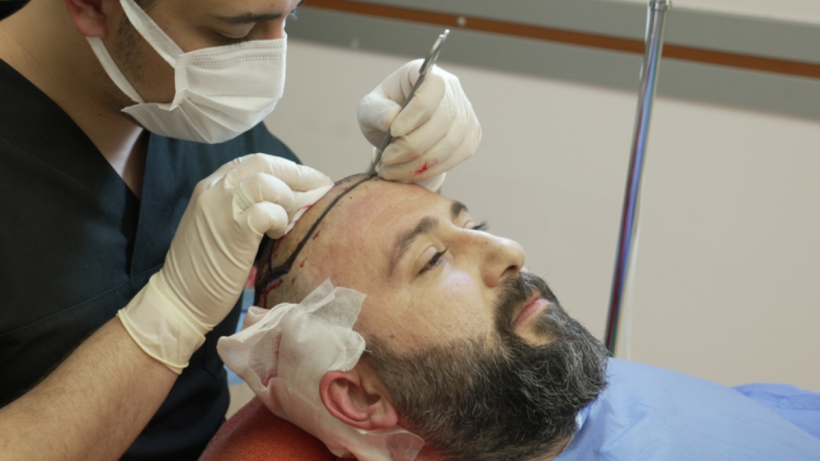Hair transplantation has emerged as a beacon of hope for many battling hair loss, offering a chance to regain both hair and confidence. However, the journey doesn’t end with the procedure; it begins anew with post-operative care, a critical phase for ensuring the best outcomes.
Today, let’s focus on a common post-transplant concern: scabs. While not the most glamorous topic, understanding how to manage these small but mighty signs of healing is key to a successful recovery.
Understanding Scabs Post-Transplant
Scabs, those tiny, crusty formations on your scalp, are more than just an inconvenience. They are, in fact, your body’s way of protecting the wound site and facilitating healing. Forming at the hair graft sites, they play a vital role in recovering after a hair transplant.
The initial 72 hours post-transplant are crucial. Your scalp will be tender, possibly swollen, and begin showing the first scabbing signs. During this time, following your surgeon’s care instructions to the letter is essential, focusing on rest and avoiding any activity that could stress your scalp.
Week 1: The Crucial Period for Scab Management
The first week is all about scab management. Your daily care routine should be meticulous, aimed at reducing scab formation while ensuring the newly transplanted hair follicles remain undisturbed. It’s a delicate balance between keeping the area clean and not disrupting the healing process.
Keeping the Scalp Clean
Maintaining the cleanliness of the scalp after a hair transplant is not just beneficial; it’s essential for preventing infection and ensuring optimal healing. In the days following your procedure, you’ll notice the formation of scabs at the graft sites. While these scabs are a natural and necessary part of the healing process, keeping the area clean is crucial to prevent complications.
How to Wash Your Scalp Safely
- Gentle Washing: Begin washing the transplanted area gently after the period recommended by your surgeon, usually 48-72 hours post-surgery. Use lukewarm water and a mild, unscented shampoo. The key is to apply minimal pressure to avoid dislodging the grafts.
- Technique: Pour a small shampoo into your hands and lightly dilute it with water. Gently apply the mixture to your scalp using a tapping motion with your fingertips. Avoid rubbing or massaging the area.
- Rinsing: Carefully rinse your scalp with lukewarm water, ensuring all shampoo is washed away without applying direct water pressure to the transplanted area.
- Drying: Pat the area dry with a soft, clean towel. Do not rub the scalp. Some clinics recommend letting your scalp air-dry to minimize any risk of graft damage.
Frequency
Initially, washing every day may not be necessary, but maintaining cleanliness is. Follow your surgeon’s advice closely regarding how often to wash, gradually returning to a more regular cleaning routine as advised.
Moisturizing: A Key to Scab Care
Proper moisturization plays a pivotal role in caring for your scalp post-transplant. Moisturizing helps keep the scabs soft, reducing discomfort and facilitating their natural and timely removal without harming the hair grafts.
Selecting the Right Moisturizer
- Surgeon-Recommended Products: Use only the moisturizing products recommended by your surgeon. These products are specifically chosen to be gentle and effective for post-transplant care, often formulated to avoid irritating the scalp or interfering with the healing process.
- Application: Apply a light layer of moisturizer to the scabs and surrounding area. The best method is to dab or gently spread the moisturizer without applying pressure. Ensure your hands are clean before touching the treated area.
Ready to embark on a journey towards a fuller, more confident you? Discover the cutting-edge hair restoration solutions that have made Dr. Vivo Hair Clinic a leader in hair transplant technology. Click here to learn more about how we can help you achieve your hair goals with our expert care and innovative techniques.
What Not to Do: Common Mistakes
After a hair transplant, the excitement of achieving a fuller head of hair can sometimes lead to careless mistakes in care. Here are some critical errors to avoid:
- Touching, Picking, and Scratching: It’s natural for the scalp to itch as it heals, but picking or scratching at scabs can dislodge hair grafts and introduce bacteria, leading to infections or impacting the success of the transplant.
- Using Unapproved Hair Products: Stick to the hair care products your surgeon recommends. Introducing new or harsh products can irritate the scalp, delay healing, or negatively affect the grafts.
- Exposing the Scalp to Harsh Conditions: Avoid direct sunlight, chlorinated pools, and dusty environments. Such conditions can harm the sensitive post-transplant scalp, increasing the risk of complications.
- Applying Heat: Avoid hair dryers, straighteners, and curling irons in the early stages of healing. The heat can damage your new grafts and the surrounding skin.
Remember, the success of your hair transplant depends not only on the skill of your surgeon but also on how well you care for your scalp afterward. Avoiding these common mistakes and adhering to your post-operative care instructions are key steps to ensuring the best possible outcome.
Dealing with scabs after a hair transplant may seem daunting, but with the right knowledge and care, it can be a manageable part of your journey to fuller hair.
Laila Azzahra is a professional writer and blogger that loves to write about technology, business, entertainment, science, and health.
